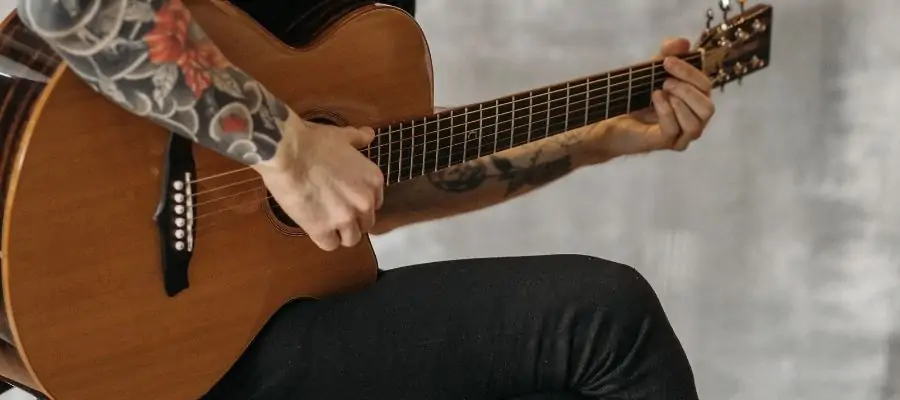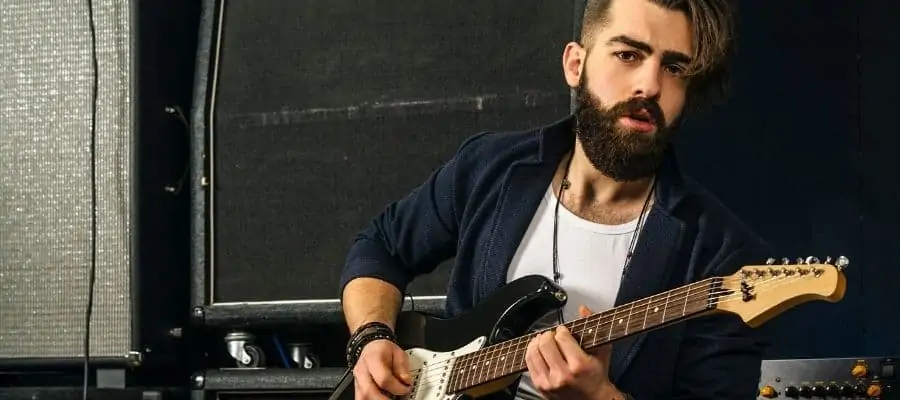One of the main questions beginner players or people who are thinking of beginning to learn guitar is if learning guitar is hard. The popularity of this instrument grew for the past fifty years thanks to blues and rock music and it only evolved further.
So, is learning guitar hard? If you plan on learning the basics only, it won’t be that hard. However, if you dream of becoming a virtuoso, it will take you lots of time and practice.
The guitar is usually not at the top of the list of easiest instruments you could learn, and if you check some of those lists of easiest instruments, you will most likely find the ukulele and harmonica.
Learning Can Be Easy And Hard

Guitar playing is not that much focused on the music theory, and it is more likely that you’ll learn how to play the guitar without a single day in music school compared to the piano. As you can imagine, there are easier and harder instruments that you could learn.
Furthermore, the easier part would be the so-called shapes, that guitar players use. If you know one chord, you could use that shape to play all the other chords. For example, the shape for G# Major is the same as the finger shape for C Major. Of course, there are variations, but that will give you an instant edge compared to other musicians.
On the other hand, When you are playing the piano, you have white and black keys and music theory is revolving around the piano. The guitar is a bit different, and there will be easy parts and others that are a lot harder. Depending on you and your focus and music genre, you might have some trouble. Since the guitar has a lot more options, notes, and techniques compared to the ukulele, you will need to invest a lot more if you plan on conquering this instrument.
One of the best things about today, is that information and lessons are easily obtained. You won’t have to find one guy in your town with a good book about guitar playing. You could find all the lessons online in no time. There are so many great courses and lessons that will teach you from zero.
If you are considering to start playing guitar and looking for an acoustic guitar on a budget and to save you time searching I made the following post Top 20 Budget Acoustic Guitars Under $100, $150, $200, $300 For Beginners
Challenges You May Faced While Learning Guitar

No matter how much you practice, some things are difficult for every beginner. Of course, you can overcome these challenges, but it won’t be easy.
Barre Chords
These chords require you to use one finger to press all six (or five) strings at once. Beginner players need the practice to figure out the best way to do this, and to improve the strength and grip of their fretting hand.
if you feel like your fingertips are not strong enough while playing these songs make sure to check my 11 Easy Tips on How To Toughen Up Your Fingertips
Chord Changes
Besides barre chords, there are so many others and you’ll need to switch between them fluently. Practice with only a few chords at the beginning, and keep adding new ones until this is no longer a problem.
If you want to improve your guitar chacing see the following lesson I have written 17 Tips & 5 Exercises To Improve Your Guitar Chord Changing
Dropping The Pick
If you are playing with a guitar pick, you will drop it, and you will drop it often. The guitar pick or plectrum can easily fall out of your hand and you’ll need to practice and find the best way to hold it without it slipping when you play.
If you have issues with your guitar pick staying in your hand, then read my post How To Hold A Guitar Pick – Best Way, Techniques And More
Left-Right Coordination
You need to coordinate your hands to fret the string you’re plucking at it can be difficult at the beginning. However, with enough practice, you’ll conquer this challenge in no time.
Proper Fretting
One of the main issues is playing each of the notes properly. When you play a certain note, there should be no buzzing, no muffled notes, and everything should be clear. This might take some practice to find a perfect hand position.
How Many Hours Should You Practice Guitar?

Depending on your wishes and your level, you might need to play a half-hour a day or two hours a day or even more and there is no golden rule of how much practice do you need. Beginners can practice up to 30 minutes a day and it will be enough. Advanced players can practice a lot more because they have many more things to practice.
However, one thing is even more important than the time you practice, which is commitment. You need to commit and you need to practice. When it comes to practice, it is important to have consistency to build muscle memory and playing habits. This is where commitment comes. If you spend even half an hour each day playing and practicing, you will soon see progress. Of course, the more you practice the better you’ll get.
But it is important to practice every day to make some progress. Beginners usually believe that all is about quantity and that it is enough to play seven hours one day, and then rest for the week. However, you will have much better results if you do one hour each day. One of the rules of guitar practice is that if you learn slow, you’ll forget slow. Take your time, and enjoy the journey.
If you are interested to know more about practice time, I dedicated a whole post so you can check How Much\Often Should A Beginner Practice The Guitar?
How Long It Might Take To Learn Guitar?

This mostly depends on the person, goals, and time you spent playing. If you plan on learning chords only, and to be able to play some simple songs, with enough practice you might be there in several months.
However, if you plan on creating your music, and playing incredible solos, and becoming a guitar player like Stevie Ray Vaughan, it will take you a lot longer. Music is such a huge area, that even after fifty years, there will be so many things you don’t know.
If you play four or five days a week, around half an hour per session, you will have incredible results in only six months. You will probably be able to play chords, strumming patterns, you’ll be able to read tabs, and probably do some cool solo. The commitment is quite important and in just six months you will be able to do a lot even if you never had any experience playing instruments.
So, the answer to how long it might take is? depends. If you want to play for more than 30 minutes each day, that’s great! You will be able to do a lot more in six months. On the other hand, if you want to play ten minutes each day, that’s also great. You won’t be able to play complex guitar solos after six months, but maybe that’s not your goal and you will be equally happy as someone who plays for hours each day. So be sure to set your own goals and plan what kind of guitar player you want to be.
Can You Learn Guitar By Yourself?

If you never had experience playing an instrument, it can be quite hard. Especially if you don’t have any learning material and you plan on doing everything by yourself. However, it is quite possible. Many famous guitar players learn to play all by themselves and it is something that you could do as well.
It might take you longer to realize what is important and what you should focus on, but it’s not impossible. Others that go to music school will follow some kind of program and it will be a lot easier because they won’t have to plan anything, and there will be someone to point out their mistakes and tell them what they should change or improve.
However, even if it might take you longer, the results will be incredible. I believe that if you focus and practice hard you will have equal or even better results because you analyzed everything and created your own logic behind it. Furthermore, one of the great ways you could practice is playing along with the records of your favorite guitarists. This will allow you to learn incredible licks and phrases, as well as practice your musical ear. But be prepared that it might take you a while.
Just don’t forget that guitar players like Stevie Ray Vaughan, Eric Clapton, and B.B. King all taught themselves how to play and they practiced and learned from their “mentors” and guitar players that they loved and they didn’t have the internet, so you could do the same!
As You Progress Learning Guitar It Will Get Harder

When you start playing the guitar, you will start with the basics. While these might look difficult, you should be aware that they are basics for a reason, and everything from that point will get more and more difficult.
When you start progressing, and you finally manage to play some strumming patterns and play an entire song, you will notice how easy it is and you will be able to understand your potential options and paths you could take.
It is quite easy to start playing and to learn the basics of the guitar, but everything from there on becomes even more difficult. So be prepared and know that everything will get more complex, and there are so many things that you could learn.
However, if your goal is to learn only the basics, then you should have no problems with that. Of course, if you strive for more, you should know that it is a rocky road in front of you and that you’ll need hours and hours of practice and quite a lot of dedication before you’re able to play the guitar like your idols.
The music is complex, and the more you practice and the more you learn, you will realize how much more you could do and how little you know. Luckily, the best thing about this thirst for knowledge is that it can be easily fed with more practice and theory and scales and licks. In the end, the only limit there is you.
Conclusion
The guitar is not the hardest instrument to learn, nor is it the easiest. You will need to practice a lot if you really want to learn how to play, and there is no way around it. If you know someone who plays really well, then you should know that he spent hundreds of hours playing.
There will be no shortcuts and no easier way, so all you have to do is figure out the path you want to take, and then practice towards your goal. Eventually, you will be there with enough practice.
If you found this article useful, you may want to save this pin below to your Guitar board.

Recent Posts
When learning new songs have you noticed that some of the chord sequences sound really good? But when you tried to come up with your own chord sequence, or as we call it chord progression, you found...
Some guitarists insist on buying an expensive amplifier with their electric guitar. They assume that this is a must for every type of guitarist out there. However, in some situations, this isn’t...

